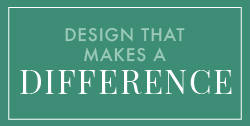If you would have told me a couple decades ago that I would be starting my own business in my late 20s, I would have laughed and said, “no way!” But there I was, a 28-year-old designer and solopreneur saying yes to a 182-room Courtyard by Marriott historic conversion. It was my first project on my own and a massive undertaking, so the pressure was on to prove myself in both business and design.
Luckily, I was prepared. At the time I had over five years of experience working three previous jobs out of art school. I created prototypes for Extended Stay America, designed Sandals Resorts for Hospitality Purveyors Inc, and worked for a small design firm that specialized in business hotels. I certainly wouldn’t recommend starting a business with only five years of experience, but it was enough to get me going.
Another aspect of the project I had working in my favor was the client, Tim O. He and I had worked together on a project for my previous design firm, and it was a very positive experience. He was very professional and personable, and he put me at ease as a young designer. He valued my thoughts, ideas, and designs. In his pitch for this project, he said, “This may be the most challenging project you will ever do, but I know you can do it.” Naturally, I was thrilled to start working more closely with him. Even if I didn’t feel qualified, I was determined not to let Tim down.
Four Things I Learned from my First Project
Whether you’re starting your own studio or working on a team, keep in mind these four lessons I learned during my debut project as JAI.
1. Design is Problem Solving
I was very excited to start working on the Courtyard by Marriott design. Not only was it a historic conversion, but was located in Pittsburgh, a city with incredible history and a very strong arts influence. My excitement, however, was matched by nervousness. There were many problems with the current layout that I had to address in my design. One of the first steps was to create a lightwell in the center of the warehouses. To do this, we had to cut out a large section, and there was no going back.
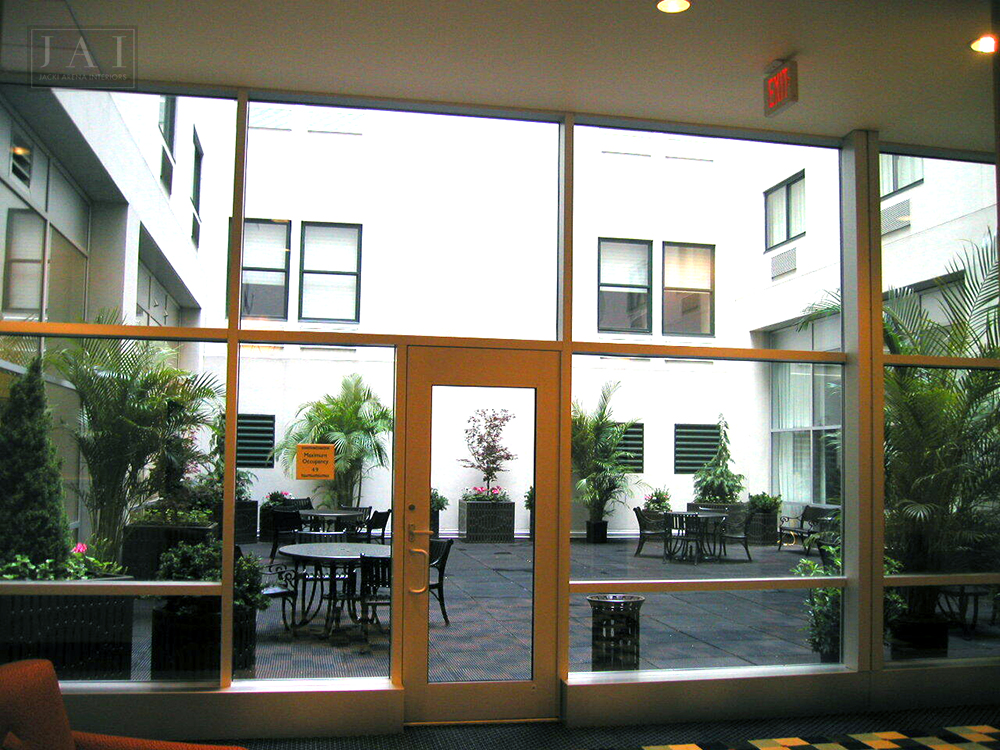
With every piece of the hotel that was completed, I picked up new tricks that I would use in future projects. I learned adding curves to a boxy space can be done very successfully. I learned to never use an upholstery fabric in the same color as the adjacent walls as the furniture would visually disappear.
As designers we work a lot in 2D design. When looking at my carpet in plan view, this fabric was perfect. Back in 2001, we didn’t have 3D renderings to study all aspects of a space so it wasn’t until the furniture was installed in the lounge did I see the fabric and walls didn’t work together. Now I remind my designers often to consider everything around the one item they are making a decision on. I am grateful for that lesson early on!

Another interesting challenge was one floor of the hotel that had high ceilings in the guestroom. In order to save money on wallcovering and to visually make the room feel more scalable and inviting, we mounted a 1” picture molding (strip of wood) at 8’ high where we ended the main lightly patterned wallcovering. We then painted the picture mold and the 2’ of drywall above that a neutral color to give the room a better proportion. It also saved the client money by not having to purchase that much more wallcovering. As a designer, I love high ceilings – the higher the better. But high ceilings backfire if the walls and overall space is not treated in proportion to the ceiling height.
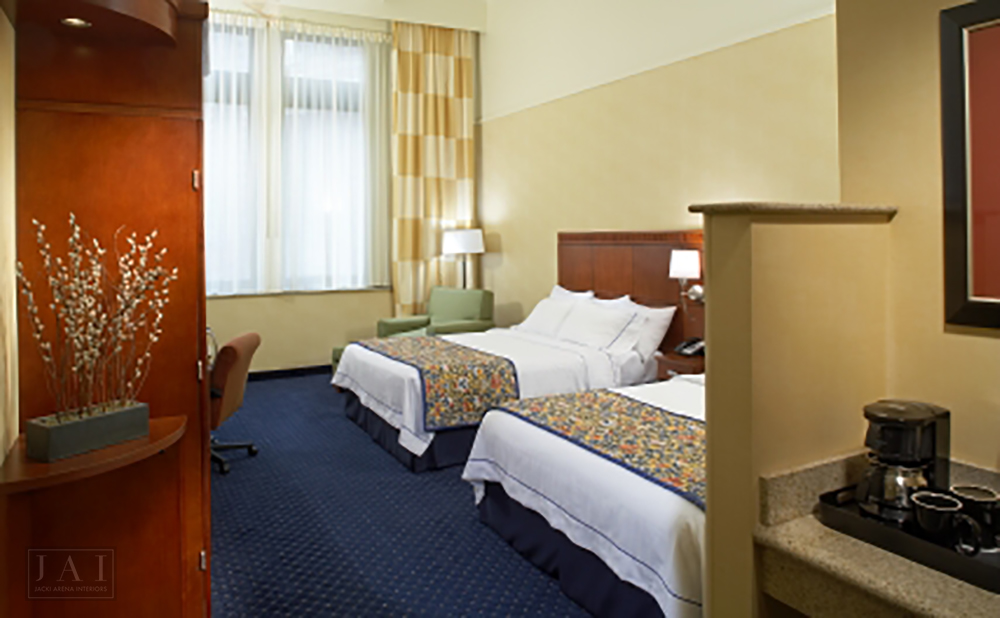
Perhaps my biggest challenge working on this hotel was breaking out of my need to make a symmetrical design out of a long rectangular space. An architect reviewed my space plans, told me to go home, drink a bottle of wine to loosen up, and try again. He scared the heck out of me and I felt defeated, but through that critique, I was able to start again and create a much more interesting space full of curves and great flow.
A number of years later, I would draw from that feedback and experience when faced with a similar rectangular space when converting condominiums into a fully custom Residence Inn in Pompano Beach, FL for the same client. I was much less frustrated by the challenges of the space and could share my experience with my design team to create another beautiful hotel. As I designed more hotels, I was able to identify issues and deploy solutions at a much quicker pace.
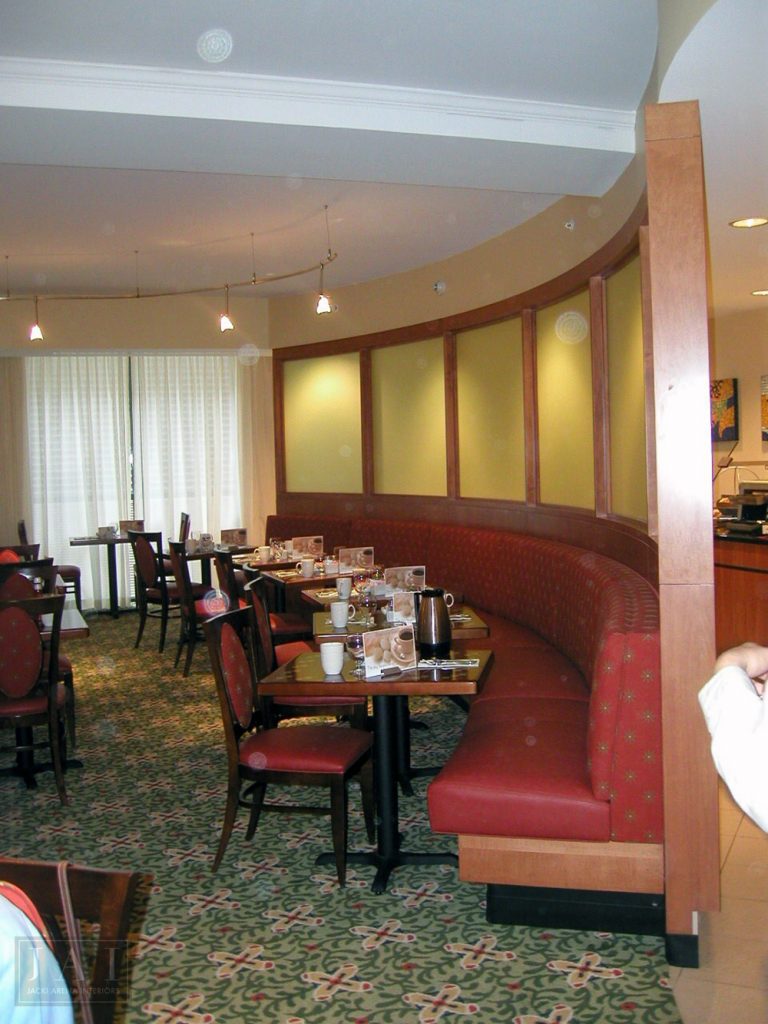
2. Running Your Business is as Important as Beautiful Design
Something that many first-time solopreneurs don’t consider is that you must provide the design and run the business all on your own. For my first project and a few that followed, I had to wear all the hats. I was the owner, the visionary, the marketer, the designer, the draftsman, the spec writer, and the project manager. At the time, I didn’t know any different.
Fast forward twenty years and the thought of it makes my head spin. If I did all of that now, I would not have other projects waiting in the pipeline and I would burn out very quickly. Through my experiences, I’ve discovered my primary strength is building relationships. My secondary strength is design. Even more specifically, leading, directing, and growing the design skills of others. I worked hard back then. But now I work smart.
3. When You Do all the Work, You Reap all the Reward
Construction on the Courtyard by Marriott was completed three years later in 2004, and I remember the grand opening vividly. I was nervous leading up to the event, but once it was finally opened I felt confident and extremely accomplished. This hotel was my baby for so long, and to see it come to life was incredible. Euphoric, even. Needless to say, I was hooked.
Designing every project is a roller coaster ride. There are so many ups and downs, times I love it and times I want to quit. Then it opens and it is the greatest feeling in the world. Our projects take anywhere from 18 months to four years and it is always disappointing when a designer cannot be there to see their project to the end because they never get to experience that feeling.
People ask if I would change anything about designs I’ve done in the past. The truth is, there are always things we could have done differently. We see new products and inspiration all day every day. When we create a design package in the first 3-6 months of a project, but don’t see it completed for 12-36 months, a lot can change, except the design. For that reason, I don’t try to think about what I could have done differently, but instead what I learned and can put into use on my next project.
A big takeaway from my first project was to always consider the big picture. You may get stuck on one detail for hours or days, but in the grand scheme of things, once the hotel is open, that one detail you struggled so much over is hardly noticeable in the overall design. When stuck, take a step back to get a more holistic perspective.
4. Design is Built on Relationships
Ultimately, I was very happy with the final product of my design. Even more, I was very proud of how hard I had worked, how much I learned, and that I did it on my own. My client was right, I could do it!
This Courtyard conversion spurred a great partnership with Tim. We’ve tackled many projects together in the past 20 years. To this day he remains a great mentor and friend (If you’d like to read more about our working relationship, I’ve detailed how Tim inspired my people-first approach to design). I recently talked to Tim about that first project and our first few years working together:
Jacki and I have truly enjoyed a 20-year rewarding journey together. Time has forged a wonderful working relationship and valued friendship. In addition to being a very talented interior designer one of Jacki’s best attributes was always listening to me (the client) even when it was painful. Jacki would always stay composed and return with exciting design options. I worked hard to wear her out and challenge her to the limits.
I met Jacki in her previous life working for a design firm in Fort Lauderdale. During the design process, it became clear she was talented, creative, and quickly understood the hospitality dynamics of balancing great design within a realistic developer budget that was still able to meet the design and durability test of time. One day I received a call from Jacki letting me know she was making some changes moving forward in her life. It was an exciting and probably scary time for her as she moved her life to a new city and ventured out on her own starting up her own JAI interior design. It was equally exciting for me to be able to offer her first solo hospitality design project which was absolutely beautifully crafted.
Since those early days, Jacki has weathered many storms but has maintained her passion, honed her skills, and persevered to grow a very successful interior design business. I am very proud to be her friend and partner during the journey. Stay tuned for the next chapter as the journey continues.
